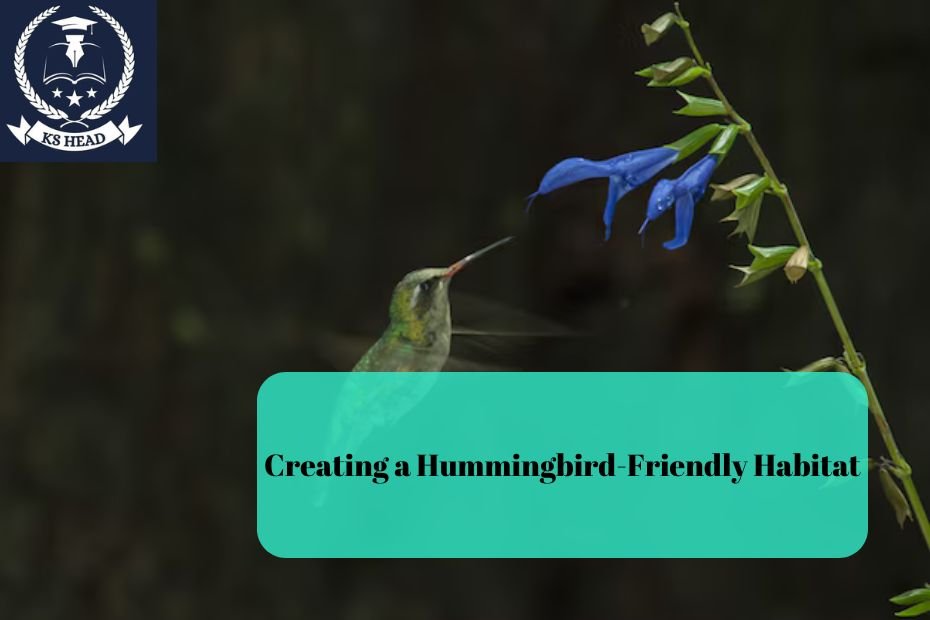Hummingbirds are remarkable creatures, known for their vibrant colors, incredible flying abilities, and unique feeding habits. Creating a hummingbird-friendly habitat in your backyard or garden not only attracts these beautiful birds but also contributes to the local ecosystem. In this article, we will explore the essential elements needed to establish a hummingbird-friendly environment, including the types of plants to choose, the importance of water sources, and how to provide shelter and nesting sites. By the end of this guide, you will have the knowledge to transform your outdoor space into a haven for hummingbirds.
Understanding Hummingbirds
Before diving into habitat creation, it’s essential to understand what hummingbirds need to thrive. There are over 300 species of hummingbirds, primarily found in the Americas. They are most often attracted to colorful flowers that produce nectar, which is their primary food source. Hummingbirds are also essential pollinators, helping to fertilize flowers as they feed. Creating a welcoming environment for these birds encourages biodiversity and supports local ecosystems.
Hummingbird Feeding Habits
Hummingbirds have specialized feeding habits. They use their long, slender bills to extract nectar from flowers and can consume up to twice their body weight in a day. They are attracted to bright colors—especially red, orange, and pink—as these colors often indicate a high nectar content. Additionally, hummingbirds require protein sources, which they obtain from small insects and spiders. It’s crucial to provide both nectar sources and protein sources to ensure their health and well-being.
Essential Elements of a Hummingbird-Friendly Habitat
1. Nectar-Rich Flowers
The most important aspect of a hummingbird-friendly habitat is an abundance of nectar-rich flowers. Here are some tips for selecting the right plants:
Choosing the Right Flowers
- Color: Opt for bright, vibrant colors. Hummingbirds are particularly drawn to red, orange, and purple flowers.
- Variety: Include a variety of plants that bloom at different times throughout the season to provide a consistent food source. Some popular choices include:
- Trumpet Vine (Campsis radicans): Produces bright orange flowers that are a favorite among hummingbirds.
- Bee Balm (Monarda): This perennial offers red, purple, or pink blooms and attracts both hummingbirds and bees.
- Salvia: Many species of salvia, particularly those with red or purple flowers, are excellent for attracting hummingbirds.
- Cardinal Flower (Lobelia cardinalis): Known for its striking red flowers, this plant thrives in wet areas.
- Hibiscus: Large, colorful blooms provide ample nectar and attract hummingbirds in warmer climates.
Planting Tips
- Group Plantings: Plant flowers in clusters rather than scattering them throughout your garden. This makes it easier for hummingbirds to find food.
- Sunlight: Most nectar-rich plants prefer full sun, so ensure your garden receives adequate sunlight.
- Native Plants: Whenever possible, choose native flowering plants. Native species are well-suited to local climates and attract local hummingbird populations.
2. Hummingbird Feeders
In addition to planting flowers, consider adding hummingbird feeders to your habitat. Feeders can supplement natural food sources, especially during times when flowers are not blooming.
Selecting Feeders
- Design: Choose feeders with red accents to attract hummingbirds. Look for feeders with wide feeding ports, as these make it easier for birds to access nectar.
- Material: Opt for glass or high-quality plastic feeders that are easy to clean and refill.
- Capacity: Select feeders with a capacity that matches your needs. Smaller feeders need to be refilled more frequently, while larger feeders may attract more birds.
Preparing Hummingbird Nectar
To create a homemade nectar solution for your feeders, follow these simple steps:
- Mixing: Combine one part white granulated sugar with four parts water (e.g., 1 cup sugar to 4 cups water).
- Boiling: Bring the mixture to a boil to dissolve the sugar completely, then let it cool.
- Storage: Store any unused nectar in the refrigerator for up to two weeks. Avoid using red dye or other additives in your nectar.
Maintenance
- Cleaning: Clean feeders every few days to prevent mold and fermentation, especially in warm weather. Use a mixture of hot water and white vinegar or a mild soap to clean them thoroughly.
- Refilling: Keep feeders filled during the hummingbird migration season (typically spring and fall) to attract these birds.
3. Water Sources
Hummingbirds need water for drinking and bathing. Providing a clean water source is crucial to creating a welcoming environment.
Types of Water Sources
- Bird Baths: Shallow bird baths with a gentle slope allow hummingbirds to safely access water. Ensure the water is shallow enough for them to perch.
- Misters and Drippers: Hummingbirds are attracted to the sound of running water. Misters or drippers can provide a continuous source of water that attracts them.
- Waterfalls or Ponds: If you have the space, consider adding a small pond or water feature. Ensure it has shallow areas for hummingbirds to land safely.
4. Shelter and Nesting Sites
Providing shelter and nesting sites is essential for attracting and retaining hummingbirds in your habitat.
Natural Shelter
- Trees and Shrubs: Plant trees and shrubs that offer cover and nesting opportunities. Some good options include:
- Native Trees: Oak, maple, and dogwood trees provide shelter and potential nesting sites.
- Bushes: Dense shrubs, such as lilacs or rhododendrons, offer protection from predators.
Nesting Materials
Hummingbirds often build their nests using soft materials like moss, feathers, and spider silk. You can help by leaving natural materials available in your garden:
- Avoid Pesticides: Chemicals can harm hummingbirds and reduce insect populations, which provide protein sources. Opt for organic gardening methods.
- Provide Natural Debris: Allow some leaf litter, twigs, and other natural materials to remain in your garden, as these can be useful for nesting.
5. Avoiding Hazards
Creating a safe environment for hummingbirds is as important as providing food and shelter.
Minimizing Risks
- Window Collisions: Hummingbirds can collide with windows. Consider placing decals or other visual markers to make glass surfaces more visible.
- Predator Control: Keep your garden free from cats and other predators. Providing hiding spots for hummingbirds can help reduce the risk of predation.
- Avoid Pesticides: As mentioned earlier, avoid using harmful chemicals in your garden that can poison hummingbirds and reduce insect populations.
6. Monitoring and Maintenance
Once you have created a hummingbird-friendly habitat, it’s essential to monitor its health and maintenance.
Observation
- Watch for Activity: Spend time observing your garden to see if hummingbirds visit regularly. Note which plants attract them the most.
- Document Changes: Keep track of the flowers that bloom throughout the season and how hummingbirds respond to changes in your garden.
Seasonal Maintenance
- Refill Feeders: Regularly refill feeders and ensure that nectar is fresh and clean.
- Plant Care: Prune and care for your flowering plants to ensure healthy growth and continuous blooming.
Conclusion
Creating a hummingbird-friendly habitat is a rewarding endeavor that contributes to the local ecosystem while providing you with the joy of observing these stunning birds. By incorporating nectar-rich flowers, feeders, clean water sources, natural shelter, and minimizing hazards, you can establish a thriving environment for hummingbirds. With a little effort and dedication, your garden can become a sanctuary for these remarkable creatures, enriching your outdoor space and fostering a deeper connection with nature.
FAQs
- What is the best time to attract hummingbirds?
- The best time to attract hummingbirds is during the migration seasons in spring and fall. Refilling feeders and planting flowers before these seasons can help attract them.
- How often should I clean hummingbird feeders?
- Clean hummingbird feeders every few days in warm weather to prevent mold and fermentation. In cooler months, weekly cleaning is usually sufficient.
- Can I use food coloring in hummingbird nectar?
- No, it is not recommended to use food coloring or artificial sweeteners in hummingbird nectar. Simply use a mixture of sugar and water.
- Do hummingbirds need protein?
- Yes, hummingbirds require protein, which they obtain from small insects and spiders. Ensure your garden has a variety of plants that attract insects to provide this essential nutrient.
- How can I keep my garden safe for hummingbirds?
- Avoid using pesticides, keep cats indoors, and use window decals to prevent collisions. Creating natural cover and nesting areas will also help keep them safe.

